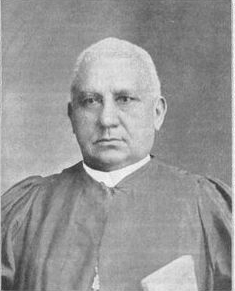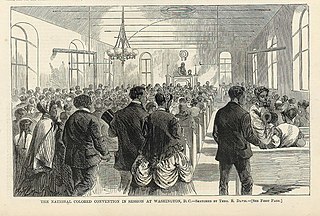
The Reconstruction era was a period in American history following the American Civil War (1861–1865) and lasting until approximately the Compromise of 1877. During Reconstruction, attempts were made to rebuild the country after the bloody Civil War, bring the former Confederate states back into the United States, and to counteract the political, social, and economic legacies of slavery.

Forty acres and a mule was part of Special Field Orders No. 15, a wartime order proclaimed by Union General William Tecumseh Sherman on January 16, 1865, during the American Civil War, to allot land to some freed families, in plots of land no larger than 40 acres (16 ha). Sherman later ordered the army to lend mules for the agrarian reform effort. The field orders followed a series of conversations between Secretary of War Edwin M. Stanton and Radical Republican abolitionists Charles Sumner and Thaddeus Stevens following disruptions to the institution of slavery provoked by the American Civil War. Many freed people believed, after being told by various political figures, that they had a right to own the land they had been forced to work as slaves and were eager to control their own property. Freed people widely expected to legally claim 40 acres of land. However, Abraham Lincoln's successor as president, Andrew Johnson, tried to reverse the intent of Sherman's wartime Order No. 15 and similar provisions included in the second Freedmen's Bureau bills.
The Black Codes, sometimes called the Black Laws, were laws which governed the conduct of African Americans. In 1832, James Kent wrote that "in most of the United States, there is a distinction in respect to political privileges, between free white persons and free colored persons of African blood; and in no part of the country do the latter, in point of fact, participate equally with the whites, in the exercise of civil and political rights." Although Black Codes existed before the Civil War and although many Northern states had them, it was the Democrat-led Southern U.S. states that codified such laws in everyday practice. The best known of these laws were passed by Southern states in 1865 and 1866, after the Civil War, in order to restrict African Americans' freedom, and in order to compel them to work for either low or no wages.

The New Orleans Massacre of 1866 occurred on July 30, when a peaceful demonstration of mostly Black Freedmen was set upon by a mob of white rioters, many of whom had been soldiers of the recently defeated Confederate States of America, leading to a full-scale massacre. The violence erupted outside the Mechanics Institute, site of a reconvened Louisiana Constitutional Convention. The Republican Party of Louisiana had called for the Convention, as they were angered by the legislature's enactment of the Black Codes and refusal to extend voting rights to Black men. White Democrats considered the reconvened convention to be illegal and were hostile towards Republican attempts to gain increased political power in the state. The massacre "stemmed from deeply rooted political, social, and economic causes," and took place in part because of the battle "between two opposing factions for power and office." According to the official report, a total of 38 were killed and 146 wounded, of whom 34 dead and 119 wounded were Black Freedmen. Unofficial estimates were higher. Gilles Vandal estimated 40 to 50 Black Americans were killed and more than 150 Black Americans wounded. Others have claimed nearly 200 were killed. In addition, three white convention attendees were killed, as was one white protester.

Jonathan Clarkson Gibbs, II was an American Presbyterian minister who served as Secretary of State and Superintendent of Public Instruction of Florida, and along with Josiah Thomas Walls, U.S. Congressman from Florida was among the most powerful black officeholders in the state during Reconstruction. An African-American who served during the Reconstruction era, he was the first black Florida Secretary of State. Jesse McCrary, who served for 5 months in 1979, was the second black Florida Secretary of State.

Rufus Brown Bullock was a Republican Party politician and businessman in Georgia. During the Reconstruction Era he served as the state's governor and called for equal economic opportunity and political rights for blacks and whites in Georgia. He also promoted public education for both, and encouraged railroads, banks, and industrial development. During his governorship he requested federal military help to ensure the rights of freedmen; this made him "the most hated man in the state", and he had to flee the state without completing his term. After returning to Georgia and being found "not guilty" of corruption charges, for three decades afterwards he was an esteemed private citizen.
The Freedmen's Bureau bills provided legislative authorization for the Freedmen's Bureau, which was set up by U.S. President Abraham Lincoln in 1865 as part of the United States Army. Following the original bill in 1865, subsequent bills sought to extend its authority and lifespan. Andrew Johnson tried to derail the bill's intention to aid freed slaves, until the Bureau was disbanded on account of rampant corruption during the first term of U.S. President Ulysses S. Grant.

This is a selected bibliography of the main scholarly books and articles of Reconstruction, the period after the American Civil War, 1863–1877.

Alexander Thomas Augusta was a surgeon, veteran of the American Civil War, and the first black professor of medicine in the United States. After gaining his medical education in Toronto, Canada West from 1850 to 1856, he set up a practice there. He returned to the United States shortly before the start of the American Civil War.
James Henry Harris (1832–1891) was an American civil rights advocate, upholsterer, and politician. Born into slavery, he was freed as a young adult and worked as a carpenter's apprentice and worker before he went to Oberlin College in Ohio. For a time, he lived in Chatham, Ontario, where he was a member of the Chatham Vigilance Committee that aimed to prevent blacks being transported out of Canada and sold as slaves in the United States.

The Memphis massacre of 1866 was a series of violent events that occurred from May 1 to 3, 1866 in Memphis, Tennessee. The racial violence was ignited by political and social racism following the American Civil War, in the early stages of Reconstruction. After a shooting altercation between white policemen and black veterans recently mustered out of the Union Army, mobs of white residents and policemen rampaged through black neighborhoods and the houses of freedmen, attacking and killing black soldiers and civilians and committing many acts of robbery and arson.
The civil rights movement (1865–1896) aimed to eliminate racial discrimination against African Americans, improve their educational and employment opportunities, and establish their electoral power, just after the abolition of slavery in the United States. The period from 1865 to 1895 saw a tremendous change in the fortunes of the black community following the elimination of slavery in the South.

Henry McNeal Turner was an American minister, politician, and the 12th elected and consecrated bishop of the African Methodist Episcopal Church (AME). After the American Civil War, he worked to establish new A.M.E. congregations among African Americans in Georgia. Born free in South Carolina, Turner had learned to read and write and became a Methodist preacher. He joined the AME Church in St. Louis, Missouri, in 1858, where he became a minister. Founded by free blacks in Philadelphia, Pennsylvania, in the early 19th century, the A.M.E. Church was the first independent black denomination in the United States. Later Turner had pastorates in Baltimore, Maryland, and Washington, DC.

The Colored Conventions Movement, or Black Conventions Movement, was a series of national, regional, and state conventions held irregularly during the decades preceding and following the American Civil War. The delegates who attended these conventions consisted of both free and formerly enslaved African Americans including religious leaders, businessmen, politicians, writers, publishers, editors, and abolitionists. The conventions provided "an organizational structure through which black men could maintain a distinct black leadership and pursue black abolitionist goals." Colored Conventions occurred in thirty-one states across the US and in Ontario, Canada. The movement involved more than five thousand delegates and tens of thousands of attendees.

Henry Lincoln Johnson was an American attorney and politician from the state of Georgia. He is best remembered as one of the most prominent African-American Republicans of the first two decades of the 20th century and as a leader of the dominant black-and-tan faction of the Republican Party of Georgia. He was appointed by President William Howard Taft as Recorder of Deeds for the District of Columbia, at the time regarded as the premier political patronage position reserved for black Americans, and one of four appointees known as Taft's "Black Cabinet".

William Jefferson White was an American civil rights leader, minister, educator, and journalist. He was the founder of Harmony Baptist Church in Augusta, Georgia in 1869 as well as other churches. He also was a co-founder of the Augusta Institute in 1867, which would become Morehouse College. He also helped found Atlanta University and was a trustee of both schools. He was a founder in 1880 and the managing editor of the Georgia Baptist, a leading African American newspaper for many years. He was an outspoken civil rights leader.
This was the first meeting of the Pennsylvania State Equal Rights League, which was a civil rights organization formed to promote equal rights for African American citizens of the state. The Pennsylvania State Equal Rights League was part of a nationwide movement to promote legal and political rights for black Americans.
Simeon W. Beard was a minister, teacher, and politician who worked in Charleston, South Carolina and then in Augusta, Georgia. He served in the Union Army. He was a delegate to Georgia's constitutional convention in 1867 and 1868. African American legislators were expelled from office in Georgia.

John Thomas Shuften (1840–?) commonly known as J. T. Shuften, was an American newspaper editor, journalist, and lawyer. He founded the Colored American newspaper in Macon, Georgia, active from 1865 to 1866. Shuften was an African American who wrote an exposé about the Reconstruction era in the American South, and what he termed as "the great betrayal of the Republican party". He practiced law in Orlando, Florida.

The Colored American published in Augusta, Georgia from October 1865 to February 1866. It was the first African American newspaper in the South. The paper was founded by John T. Shuften, who was forced to sell the paper within six months due to a lack of financial support. The paper was published by John T. Shapiro. The Colored American covered political, religious, and general news. Shuften published the newspaper with assistance from James D. Lynch. The paper was purchased in January 1866 by the Georgia Equal Rights Association, and the name was changed to the Loyal Georgian, published by John Emory Bryant.














